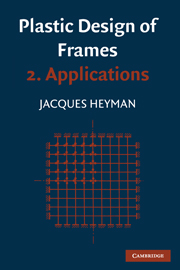9 - MULTI-STOREY FRAMES
Published online by Cambridge University Press: 05 November 2011
Summary
The type of frame to be discussed in this chapter is one which is tall enough for wind loading to be an important factor in design, and for which stability considerations may be critical. Thus a single-bay single-story frame of normal dimensions will not be tall in this sense, although the unusual frame of three bays and two storeys for which calculations are made in the next chapter is seriously affected by wind. A fifty-storey ten-bay office block is certainly tall, and so also is a ten-storey two-bay frame, but these two frames may respond to their loadings in different ways.
It is usual in the design of such tall buildings to attempt to carry the wind load to the foundations by means of bracing in the planes of the frames. Such designs are discussed in sections 9.2 and 9.4 below. However, it may prove impossible (perhaps for architectural reasons) to incorporate bracing in the structure; in the design example of chapter 10, bracing cannot be used because electrical clearances would be insufficient. All loads on the structure must then be resisted by bending of the beams and columns, and this type of frame is discussed in section 9.5. In both types of design, braced and unbraced, there are certain common features which may be discussed conveniently as a preliminary to detailed calculations.
- Type
- Chapter
- Information
- Plastic Design of Frames , pp. 242 - 267Publisher: Cambridge University PressPrint publication year: 1971



